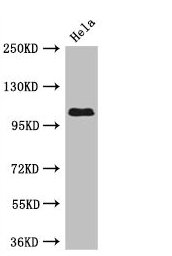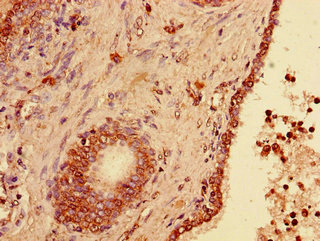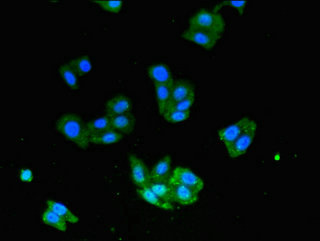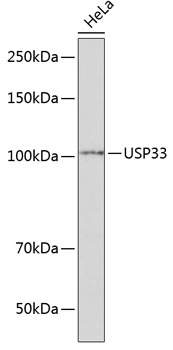
Western Blot Positive WB detected in: Hela whole cell lysate All lanes: USP33 antibody at 3microg/ml Secondary Goat polyclonal to rabbit IgG at 1/50000 dilution Predicted band size: 107, 104, 94 kDa Observed band size: 107 kDa
USP33 Antibody
CSB-PA840583LA01HU
ApplicationsImmunoFluorescence, Western Blot, ELISA, ImmunoHistoChemistry
Product group Antibodies
ReactivityHuman
TargetUSP33
Overview
- SupplierCusabio
- Product NameUSP33 Antibody
- Delivery Days Customer20
- ApplicationsImmunoFluorescence, Western Blot, ELISA, ImmunoHistoChemistry
- CertificationResearch Use Only
- ClonalityPolyclonal
- ConjugateUnconjugated
- Gene ID23032
- Target nameUSP33
- Target descriptionubiquitin specific peptidase 33
- Target synonymsVDU1, ubiquitin carboxyl-terminal hydrolase 33, VHL-interacting deubiquitinating enzyme 1, deubiquitinating enzyme 33, pVHL-interacting deubiquitinating enzyme 1, ubiquitin thioesterase 33, ubiquitin thiolesterase 33, ubiquitin-specific-processing protease 33
- HostRabbit
- IsotypeIgG
- Protein IDQ8TEY7
- Protein NameUbiquitin carboxyl-terminal hydrolase 33
- Scientific DescriptionDeubiquitinating enzyme involved in various processes such as centrosome duplication, cellular migration and beta-2 adrenergic receptor/ADRB2 recycling. Involved in regulation of centrosome duplication by mediating deubiquitination of CCP110 in S and G2/M phase, leading to stabilize CCP110 during the period which centrioles duplicate and elongate. Involved in cell migration via its interaction with intracellular domain of ROBO1, leading to regulate the Slit signaling. Plays a role in commissural axon guidance cross the ventral midline of the neural tube in a Slit-dependent manner, possibly by mediating the deubiquitination of ROBO1. Acts as a regulator of G-protein coupled receptor (GPCR) signaling by mediating the deubiquitination of beta-arrestins (ARRB1 and ARRB2) and beta-2 adrenergic receptor (ADRB2). Plays a central role in ADRB2 recycling and resensitization after prolonged agonist stimulation by constitutively binding ADRB2, mediating deubiquitination of ADRB2 and inhibiting lysosomal trafficking of ADRB2. Upon dissociation, it is probably transferred to the translocated beta-arrestins, leading to beta-arrestins deubiquitination and disengagement from ADRB2. This suggests the existence of a dynamic exchange between the ADRB2 and beta-arrestins. Deubiquitinates DIO2, thereby regulating thyroid hormone regulation. Mediates deubiquitination of both Lys-48- and Lys-63-linked polyubiquitin chains.
- ReactivityHuman
- Storage Instruction-20°C or -80°C
- UNSPSC41116161





